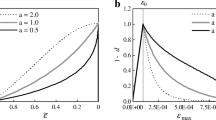Conclusion
-
1.
By means of the proposed method it is possible to investigate the stress-strain state of natural slopes, underground workings, structures containing low-strength and melting ice inclusions, extended cracks, and other objects weakened both by long and short inclusions.
-
2.
The effect on the SSS of the structure of the coefficient of shear rigidity of the interlayer for various locations of the inclusion and its various operating conditions was analyzed in the work.
-
3.
Both the coefficient of shear rigidity of the interlayerr and the operating regimes of the structure have a substantial effect on the SSS of earth structures.
-
4.
Even under the effect of only the gravitational force, the presence of a low-strength interlayer qualitatively and quantitatively affects the SSS of the structure. In turn, a short inclusion on the upstream pool side leads to a still greater increase of displacements above the interlayer toward the upper pool.
The presence of a hydrostatic surface load for the left short inclusion leads to the formation of stress concentration on its right end. For a long inclusion the formation of a zone of tensile stresses above the interlayer is observed near the left foundation of the dam during filling of the pool.
The presence of a long interlayer leads to an increase of settlement of the dam crest.
In all operating regimes of the structure, a discontinuity of the fields of displacementsU x, components of the stress tensorσ x, and other characteristics occurs along the low-strength inclusion.
Similar content being viewed by others
Literature cited
G. S. Zolotarev, Experience in Estimating the Stability of Slopes Having a Complex Geological Structure [in Russian], Moscow State Univ. (1973).
G. L. Fisenko and É. L. Galust'yan, “Estimation of the stability of the walls of deep quarries in rocks,” Gidrotekh. Stroit., No. 5 (1986).
V. S. Deineka and I. N. Molchanov, “Scheme of the finite-element method of an increased order of precision for solving problems of elasticity theory,” Zh. Vychisl. Mat. Mat. Fiz.,21, No. 2 (1981).
V. A. Florin, Principles of Soil Mechanics [in Russian], Vol. 1, Gosstroiizdat, Moscow (1951).
N. A. Tsytovich, Soil Mechanics [in Russian], Vysshaya Shkola, Moscow (1983).
I. I. Lyashko, V. V. Skopetskii, V. S. Deineka, and S. I. Rybachishin, “Numerical investigation of the stress-strain state of earth dams with consideration of seepage,” Prikl. Mekh.,22, No. 3 (1986).
I. I. Lyashko, V. V. Skopetskii, and V. S. Deineka, “Determination of the elastoplastic deformations of earth dams under the effect of seepage processes,” Dokl. Akad. Nauk Ukr. SSR, Ser. A, No. 3 (1986).
V. T. Koiter, General Theorem of the Theory of Elastoplastic Media [Russian translation], Izd. Inostr. Lit., Moscow (1961).
I. N. Molchanov, V. S. Zubatenko, L. D. Nikolenko, and M. F. Yakovlev, “The APAC software package,” in: Applied Software Packages [in Russian], Nauka, Moscow (1983).
I. I. Lyashko and L. I. Yushchuk, “System for processing geometric information for boundary-value problems,” Programmirovanie, No. 1 (1984).
Additional information
Translated from Gidrotekhnicheskoe Stroitel'stvo, No. 10, pp. 31–35, October, 1988.
Rights and permissions
About this article
Cite this article
Skopetskii, V.V., Deineka, V.S. & Rybachishin, S.I. Calculation of the stress-strain state of earth structures weakened by low-strength interlayers. Hydrotechnical Construction 22, 591–597 (1988). https://doi.org/10.1007/BF01429028
Issue Date:
DOI: https://doi.org/10.1007/BF01429028




